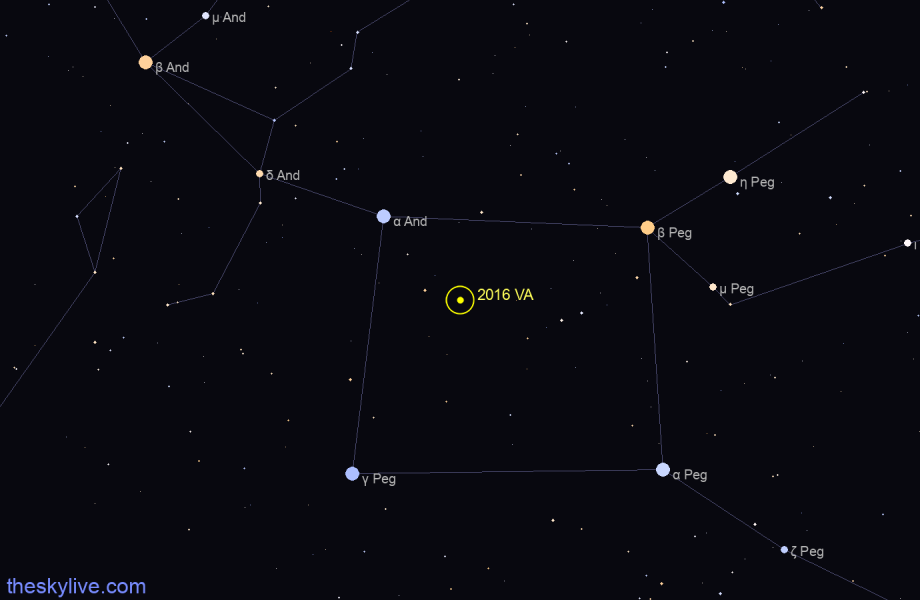Asteroid (NEO) 2016 VA
Asteroid (NEO) 2016 VA is currently in the constellation of Pegasus, at a distance of 227,392,733 kilometers from Earth.
View interactive star map
Today's rise, transit and set times of Asteroid (NEO) 2016 VA from Greenwich, United Kingdom (all times relative to the local timezone Europe/London):
- 2016 VA is above the horizon from Greenwich, United Kingdom.
- Right now it is placed in the East-South-East direction at an altitude of 43° above the horizon.
- Given its current magnitude, 2016 VA is visible only through long exposure photography.
- Go to interactive sky chart
If you need to access this information frequently for your observations, you can create a simple customized Quick Access page, so that you can easily bookmark it in your browser favorites or add a shortcut to your mobile phones' home screen.
Asteroid (NEO) 2016 VA Position and Finder Charts
Field of view: 10x6 degrees
View fullscreen
Also check out Where is Asteroid (NEO) 2016 VA?, a page that provides all the information needed to find Asteroid (NEO) 2016 VA in the sky and additional links to sky charts.
Asteroid (NEO) 2016 VA Distance from Earth
The distance of Asteroid (NEO) 2016 VA from Earth is currently 227,392,733 kilometers, equivalent to 1.520027 Astronomical Units. Light takes 12 minutes and 38.5005 seconds to travel from Asteroid (NEO) 2016 VA and arrive to us.
The following chart shows the distance of Asteroid (NEO) 2016 VA from Earth as a function of time. In the chart the distance data is measured in Astronomical Units and sampled with an interval of 1 day.
The value of the reported distance might be somewhat inaccurate around the times of closest approach for objects passing extremely close to Earth.
Closest Approach of Asteroid (NEO) 2016 VA to Earth
During the next 10 years, the closest approach of Asteroid (NEO) 2016 VA to Earth happens on Fri Nov 1 2024 at a distance of 0.003780 Astronomical Units, or 565,473 kilometers:
Asteroid (NEO) 2016 VA Brightness and Light Curve
The following chart is the predicted light curve (visual magnitude as a function of time) of Asteroid (NEO) 2016 VA, according to the most recent ephemerides data. Magnitude data is sampled with a 2 days interval and there might be inaccuracies for objects changing brightness very rapidly during the course of a few days. For comets there could be large discrepancies between the observed and predicted brightness because of their highly dynamic behaviour.
Asteroid (NEO) 2016 VA Orbital Elements
The following table lists the orbital elements of Asteroid (NEO) 2016 VA at epoch 24 February 2023 00:00 UTC (JD: 2460000.5). Source: JPL Small-Body Database
| Element | Symbol | Value |
|---|---|---|
| Orbit eccentricity | e | 0.53390992 |
| Orbit inclination | i | 29.67732201° |
| Perihelion distance | q | 0.43086016 AU 64,455,763 km |
| Aphelion distance | Q |
1.41796769 AU 212,124,947 km |
| Semi-major axis | a |
0.92441392 AU 138,290,355 km |
| Orbital period | period |
0.8888 years 324.6371 days |
| Date of perihelion transit | Tp | 2023-Mar-24 13:43:22 2,460,028.0718 JD |
| Next perihelion transit | 2024-Feb-12 05:00 2,460,352.7089 JD |
|
| Argument of perihelion | peri | 308.83488591294° |
| Longitude of the ascending node | node | 219.70740155855° |
| Mean anomaly | M | 329.42479811713° |
| Mean motion | n | 1.10893057°/day |
Visualization of Asteroid (NEO) 2016 VA Orbit
This 3d orbit diagram is a feature of our 3D Solar System Simulator and shows the orbit of Asteroid (NEO) 2016 VA with respect of the Sun and the orbits of the major planets. The position of Asteroid (NEO) 2016 VA and the planets along their orbits in this diagram accurately represents the current configuration of the objects in the Solar System. This is an experimental feature and it requires a WebGL enabled browser. Please provide us feedback!
View Asteroid (NEO) 2016 VA in the 3D Solar System Simulator
Asteroid (NEO) 2016 VA 15 Days Ephemeris
The following table lists the ephemerides of Asteroid (NEO) 2016 VA computed for the past and next 7 days, with a 24 hours interval. Click on each row of the table to locate Asteroid (NEO) 2016 VA in our Online Planetarium at the chosen date.
| Date | Right AscensionR.A. | DeclinationDec. | MagnitudeMag | Constellation |
|---|---|---|---|---|
| 2024 May 01 | 23h 09m 28s | +18° 25’ 27” | 30.40 | Pegasus |
| 2024 May 02 | 23h 11m 40s | +18° 46’ 42” | 30.41 | Pegasus |
| 2024 May 03 | 23h 13m 51s | +19° 07’ 49” | 30.43 | Pegasus |
| 2024 May 04 | 23h 16m 04s | +19° 28’ 45” | 30.44 | Pegasus |
| 2024 May 05 | 23h 18m 15s | +19° 49’ 29” | 30.46 | Pegasus |
| 2024 May 06 | 23h 20m 25s | +20° 10’ 05” | 30.47 | Pegasus |
| 2024 May 07 | 23h 22m 35s | +20° 30’ 33” | 30.48 | Pegasus |
| 2024 May 08 | 23h 24m 43s | +20° 50’ 49” | 30.50 | Pegasus |
| 2024 May 09 | 23h 26m 53s | +21° 10’ 58” | 30.51 | Pegasus |
| 2024 May 10 | 23h 29m 02s | +21° 30’ 56” | 30.52 | Pegasus |
| 2024 May 11 | 23h 31m 09s | +21° 50’ 47” | 30.53 | Pegasus |
| 2024 May 12 | 23h 33m 16s | +22° 10’ 28” | 30.54 | Pegasus |
| 2024 May 13 | 23h 35m 25s | +22° 30’ 01” | 30.55 | Pegasus |
| 2024 May 14 | 23h 37m 31s | +22° 49’ 26” | 30.56 | Pegasus |



